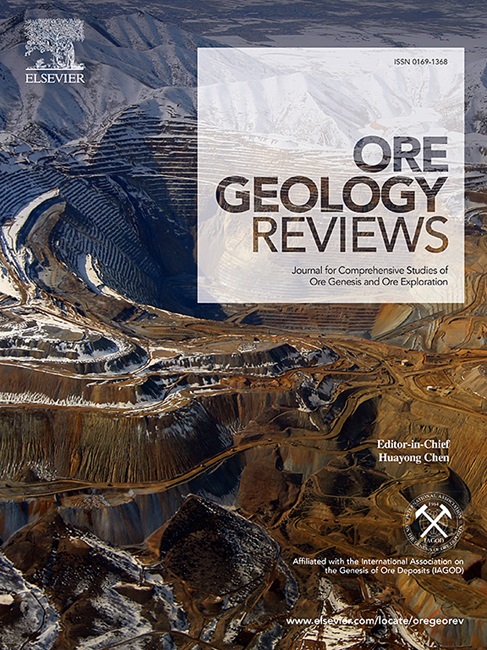Geochemical and mineralogical investigation of germanium-rich chalcopyrite veins from the Cu-Ag Kupferschiefer deposit, Poland
IF 3.6
2区 地球科学
Q1 GEOLOGY
引用次数: 0
Abstract
The underlying geological processes responsible for germanium enrichment across various mineralization types remain elusive, posing a significant obstacle to the development of a comprehensive genetic models. The investigation of germanium-rich epigenetic sulfide-calcite veins from the Cu-Ag Kupferschiefer deposit in Lubin-Sieroszowice ore district in Poland provides new insights into the mechanisms of germanium concentration in sulfide ores. Petrographic observations at macro- and microscale levels suggest that this mineralization style is consistent with single or multiple brecciation episodes likely related to natural hydraulic fracturing by overpressured fluids. Electron microprobe microanalysis (EPMA), TESCAN Integrated Mineral Analyzer (TIMA), and laser ablation inductively coupled plasma mass spectrometry (LA-ICP-MS) reveal that chalcopyrite, a predominant mineral in the veins, is also the primary host of germanium, containing up to 5 016 mg/kg of Ge. Typical associations include calcite, bornite, sphalerite, galena, and tennantite, with less common occurrences of luzonite, gersdorffite, betekhtinite, and anhydrite. Micro X-ray fluorescence (micro-XRF) mapping of massive chalcopyrite demonstrates that germanium distribution is inhomogeneous exhibiting two distinct spatial distribution patterns: dendrite-like and apparent oscillatory zoning. It is hypothesized that a rapid fluid pressure drop could be an important factor in formation of germanium-enriched sulphide ores.

波兰Kupferschiefer铜银矿床富锗黄铜矿脉的地球化学和矿物学研究
不同矿化类型的锗富集的潜在地质过程仍然难以捉摸,这对综合成因模型的发展构成了重大障碍。波兰Lubin-Sieroszowice矿区Cu-Ag - Kupferschiefer矿床富锗后生硫化物方解石脉的研究,为研究硫化矿中锗的富集机理提供了新的思路。宏观和微观的岩石学观察表明,这种矿化方式与单次或多次角化相一致,可能与超压流体的自然水力压裂有关。电子探针微量分析(EPMA)、TESCAN集成矿物分析仪(TIMA)和激光烧蚀电感耦合等离子体质谱分析(LA-ICP-MS)结果表明,黄铜矿也是锗的主要寄主,其锗含量高达5 016 mg/kg。典型的伴生物包括方解石、斑铜矿、闪锌矿、方铅矿和钛矿,较少出现的有吕长石、格斯多菲石、辉石和硬石膏。块状黄铜矿的微x射线荧光(Micro - xrf)图谱显示锗的分布不均匀,呈现出两种明显的空间分布模式:枝晶状和明显的振荡带。假设流体压力的快速下降可能是富锗硫化物矿石形成的重要因素。
本文章由计算机程序翻译,如有差异,请以英文原文为准。
求助全文
约1分钟内获得全文
求助全文
来源期刊

Ore Geology Reviews
地学-地质学
CiteScore
6.50
自引率
27.30%
发文量
546
审稿时长
22.9 weeks
期刊介绍:
Ore Geology Reviews aims to familiarize all earth scientists with recent advances in a number of interconnected disciplines related to the study of, and search for, ore deposits. The reviews range from brief to longer contributions, but the journal preferentially publishes manuscripts that fill the niche between the commonly shorter journal articles and the comprehensive book coverages, and thus has a special appeal to many authors and readers.
 求助内容:
求助内容: 应助结果提醒方式:
应助结果提醒方式:


